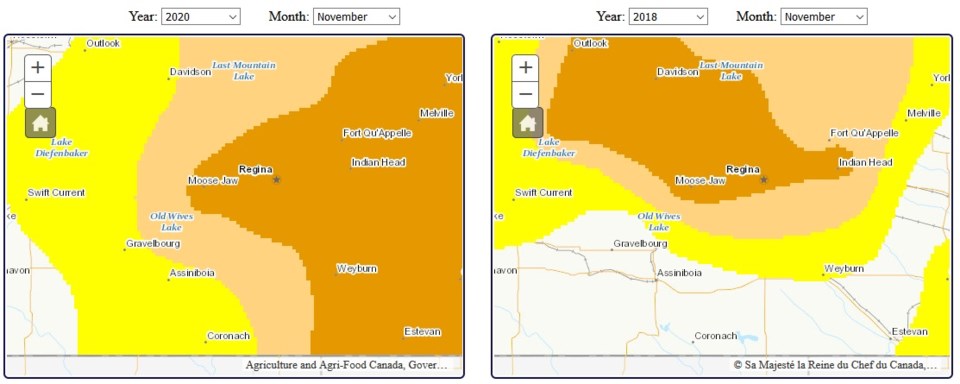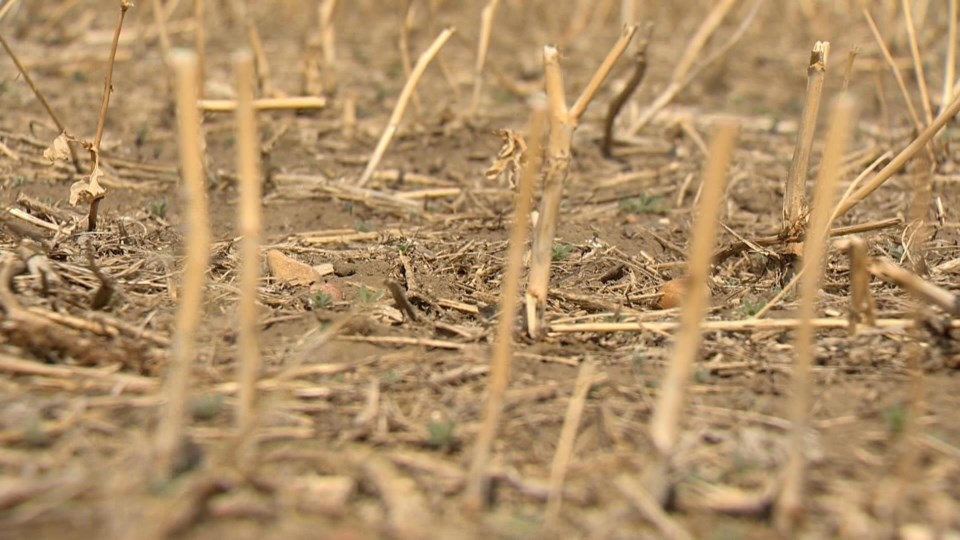The federal government predicts that the Moose Jaw region could face severe drought conditions this year due to a lack of moisture, which could negatively affect crop growth.
A map on the Agriculture and Agri-Foods Canada (AAFC) website shows severe drought conditions exist starting around Boharm — about 14 kilometres west of Moose Jaw — and extending east to Winnipeg, and from Avonlea in the south to the U.S. border and from Early Grey in the north to Swan Lake, Man.
Moderate drought conditions are expected from Boharm west to about Valjean, followed by abnormally dry conditions from Valjean west to around Swift Current.
 A look at drought conditions in the Moose Jaw region based on data from November 2020 and November 2018. Photo courtesy Agriculture and Agri-Foods Canada
A look at drought conditions in the Moose Jaw region based on data from November 2020 and November 2018. Photo courtesy Agriculture and Agri-Foods Canada From Sept. 1 to Nov. 30, 2020, the Moose Jaw area received between 10 and 25 millimetres (one to 2.5 centimetres, or roughly 0.4 inches) of precipitation.
Environment Canada also confirmed recently that 2020 was the driest year in Moose Jaw in the past 104 years.
Low water table
According to an area farmer, a lack of moisture has been noticeable southwest of Moose Jaw for several years.
“Last year, I don’t know how the heck we ended up getting the crop we did because virtually had no rain,” said the farmer, who asked for anonymity. “We had about two-and-a-quarter inches of rain on our farm, but we had good soot moisture from the year before with all the snow and everything. But this year, we have no soot moisture left at all. Absolutely none.”
Many cattle producers and farmers haul in water since the water table is low, he continued. He thought if area farmers didn’t receive any more moisture this winter, and the winter thaw didn’t produce any further moisture, it could be difficult for them to invest $200 per acre of inputs into their fields.
“But we haven’t lost a crop in January yet … ,” the farmer chuckled. “But it does not look very good right now.”
Ministry of Agriculture
There were lower-than-normal moisture levels in the area during the 2020 growing season — by as much as half in some places — based on last year’s crop reports, confirmed Sara Tetland, a crops extension specialist with the Ministry of Agriculture. It was dry in the late spring and fall, which was good for crop quality and a speedy harvest. However, the crop reports recorded that moisture levels were either short or very short.
While there has been snow this winter, more moisture is needed.
“The snow really helps in the spring. Once it melts, it will infiltrate into the soil, which is really good for crop growth in the spring,” she continued. In comparison, 2019 was a wetter year with early rain and early snow that affected planting and a speedy harvest.
Moisture is important in the spring since the seeds need that liquid to germinate, grow, and become robust, while it also gives them an edge over weeds and pests, Tetland said. Farmers can plant their seeds deeper to find that moisture, but that reduces the seeds’ ability to spring up.
Agricultural Producers Association of Saskatchewan
“Really, for a lot of the province, especially Moose Jaw area and south and west of there, it’s a pretty critical situation that we get some snowfall, not only to replenish surface water sources and for livestock and for even for spraying, but (also for) the cropland (that) are in desperate needs of recharge,” Todd Lewis, president of Agricultural Producers Association of Saskatchewan (APAS), told the Express.
There was not a common weather system in 2020 that could have recharged all areas at one time, he continued. Instead, farmers relied on passing storms to supply them with precipitation. That is why more snow in the winter or rain in the early spring would help recharge moisture levels.
Farmers won’t be able to grow crops and producers won’t be able to grow grass for their cattle if there is no precipitation, Lewis said. While farmers are growing more crops with less rain, they are in a situation where drought conditions will soon affect yield quality and potentially delay seeding.
Farmers have adapted by moving to zero-till agriculture and investing in better equipment, which contributed to record crops last year, he continued. Furthermore, producers have adapted their pasturelands, so there is less overgrazing by their animals.
“Everybody is hoping to see some grey skies coming and either snowfall or rain,” Lewis added. “We certainly don’t need any wind like we had (recently), that’s for sure.”




